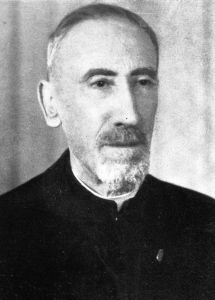Jesuit and Astronomer
 On 8th August 1886 Ernesto Gherzi, Jesuit father and world-famous scientist in the field of weather forecasting, was born in Sanremo.
On 8th August 1886 Ernesto Gherzi, Jesuit father and world-famous scientist in the field of weather forecasting, was born in Sanremo.
After his childhood in Sanremo, he studied at the Apostolic College of the Principality of Monaco and on 17th October 1903 he entered the Society of Jesus, beginning his novitiate in the province of the Jesuit Fathers of Paris where he obtained a baccalaureate in literature. In October 1910, after perfecting his skills in meteorology and seismology in Paris, he left Marseilles for Shanghai, where he taught physics at the Jesuit-ruled "Aurore" University.
Returning to Europe in 1912 due to illness, he worked after his recovery in London with E. Appleton, carrying out studies on the characteristics of the ionosphere on behalf of the Admiralty. He completed his theological studies and was ordained a priest in London on 29 June 1916. During the First World War he served as assistant chaplain to the Inter-Atlantic Navy at the English Channel bases.
After obtaining a doctorate in philosophy at the Institute of Philosophy of the Jesuit Fathers in Paris, he returned to China in October 1920, where he was assigned to the meteorological and seismic observatory established at the end of the nineteenth century by the Jesuits in Zi-ka-wei, near Shanghai. Initially Gherzi was director for seismology and assistant director for meteorology; in 1930 he became director of the Zi-ka-wei observatory and held this position until 1949, when the communist forces occupied Shanghai.
At that time in Manila for a congress, Gherzi never returned to Shanghai. He initially worked at the Royal Observatory in Hong Kong and then, in response to an invitation from the Portuguese government, set up a geophysical observatory in Macao which he ran until 1954.
He went to the United States to give a series of conferences, spent a few months at Saint Louis University and Loyola University in New Orleans (LA), and then moved to Canada in 1955 where he became director of research at the Observatoire de géophysique Jean de Brébeuf in Montreal.
Gherzi's scientific interests focused mainly on meteorology and seismology. In the Far East in 35 years he studied the evolution of about a thousand typhoons. This enabled him to develop an empirical system of forecasting the formation and displacement of such disturbances. He achieved considerable success in predicting typhoons, based on traditional synoptic empirical methods, which included the study of thermodynamic factors in the atmosphere (heat, pressure, humidity) and other factors such as the distribution of solar radiation, the characteristics of the ionosphere, the electrical potential of the air and the intensity of cosmic rays. According to the technique developed by Gherzi, the forecast was based on continuous examination of the available data and continuous radio contact with the ships at sea, which provided meteorological observations and in return received indications of the expected course of the typhoons. Since 1930, with the start of international flights, the Gherzi was also responsible for letting the companies' aircraft leave and arrive. The forecasting system required maximum vigilance as soon as an atmospheric disturbance occurred even at a distance of 4000 km and required the continuous sending of data to the stations, such as cloud height and movement, variations in the isobar of 700 millibars (about 3 km), variation in pressure in the area surrounding the centre in motion (linked to the future path of the disturbance), wind speed and direction. About the origin of tropical cyclones, he claimed that they were triggered by convective cells produced by the difference in temperature between the sea and the numerous small islands scattered at low latitudes.
After the Second World War, however, a school of meteorology - which had its founder in C.G. Rossby - was established, characterised by a more rigorous physical-mathematical approach, and Gherzi's experience was not used when the forecasting service for the seas of the Far East passed to the United States.
In seismology, Gherzi put forward the hypothesis that certain types of microsisms were caused by pressure oscillations in tropical cyclones transmitted by liquid mass to the ocean floor; this hypothesis was confirmed by seismological surveys carried out in the years 60s.
In Montreal, Gherzi dealt mainly with atmospheric electricity, radiometeorology and solar radiation.
Member of the Pontifical Academy of Sciences since 1936, of the Academy of Sciences in Lisbon, of the Academy of Sciences in New York, of the International Maritime Meteorology Committee and of the International Commissions of Synoptic Meteorology, Hydrography, Seismology, Atmospheric Electricity, he was meteorological adviser to the Commercial and Civil Aviation of the Chinese government and member of the Canadian Meteorology Association and the American Meteorological Society. Endowed with great temperament and passion for his work, Gherzi was always aware of the service value of his work, especially during the Zi-ka-wei years.
He died on 6 December 1973 in Saint-Jerome (Quebec, Canada).
The G. wrote a great deal: 104 books and large brochures and about one hundred articles. It is very difficult to compose a complete bibliography because he paid little attention to this aspect and because modern scholars of tropical meteorology tend not to mention it. Gherzi published a lot in periodicals edited by him.
(source: Marco Mauro: Treccani)




